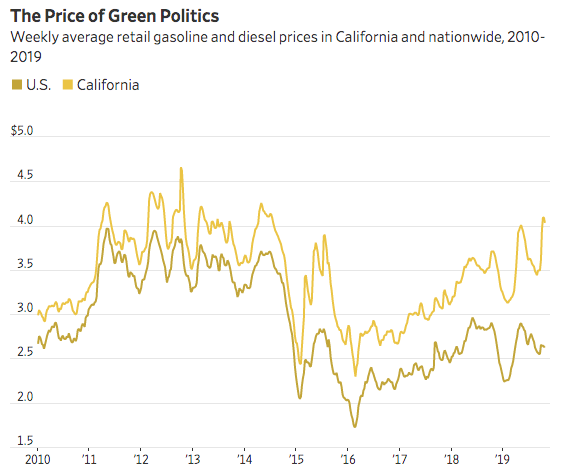According to AAA, California’s gasoline prices are the highest in the United States and are $1.45 more than the average U.S. gasoline price. While California’s governor, Gavin Newsom, wants to blame the oil companies and has asked his attorney general to investigate them for conspiring to keep gasoline prices artificially high, he should be looking at his state’s laws and regulations as the main culprit. According to the state’s Energy Commission, about half of the price difference between California’s gasoline price and the national average gasoline price is due to California’s taxes, its cap-and-trade policy, and its low-carbon fuel standard; and another third is due to higher refiner and retailer margins because of higher regulatory costs and less competition.

California’s Special Blend and Lack of Infrastructure
California’s gasoline is a special “boutique” fuel, which few refineries outside of the state make and which adds about 10 cents a gallon to the cost of gasoline. When a refinery in the state has an outage, gasoline must be imported by tanker at higher cost because there are no interstate pipelines to bring gasoline into California. If a refinery outage within the state occurs, as it did this year, gasoline prices spike.
Cap-and-Trade Program, Low Carbon Fuel Standard
In 2013, the state’s cap-and-trade program took effect. It is part of the state’s strategy to reduce its greenhouse gas emissions to 1990 levels by 2020 and 40 percent below 1990 levels by 2030. The program applies to large electric power plants, large industrial plants, and fuel distributors, including natural gas and petroleum. The state’s low-carbon fuel standard is also meant to reduce greenhouse gas emissions. It applies to fuels used for transportation, including gasoline, diesel, and their alternatives.
Taxes and Fees
California drivers pay about 77 cents per gallon for federal, state, and local taxes and fees. One of those taxes—the 2.25 percent sales tax—is formulated as a percentage of the total. When there is an increase in the underlying price of gasoline, the sales tax also increases. In 2017, California instituted the first phase of an increase in its gasoline tax of 12 cents per gallon to help pay for road repair as part of Senate Bill 1, The Road Repair and Accountability Act. The bill’s full effect was realized in July 2019 when the total amount in excise taxes increased to 47.3 cents a gallon. Despite this tax increase, there is no apparent change in road conditions and few new roads under construction. Apparently, about $2.6 billion were diverted for grants to fund transit projects. California also has an underground storage tank fee that comes to about 2 cents per gallon.
Retailer Margins
The commission also noted that retailer margins increased since 2012, especially among certain gasoline brands like 76, Chevron, and Shell. Between 2010 and 2018, California brand-name station margins increased by about 30 cents a gallon versus six cents on average nationally. The report by the Energy Commission suggests that Californians could be buying the higher priced gasoline at name-brand stations because those stations are more conveniently located, take credit cards, or are perceived to have a higher quality product. Since about 95 percent of gasoline stations with convenience stores are independently owned, the difference does not mean that oil companies are gouging.
Further, the commission did not factor into retail margins the impact of labor costs, utilities, rent, and taxes. In 2012, the state increased taxes on high earners, which affected many small businesses. Since 2013, California’s minimum wage increased by 50 percent. According to the Bureau of Labor Statistics, worker wages at California gasoline stations over the last five years increased 50 percent more than nationwide.
Conclusion
Last year, California’s gasoline prices were about 77 cents higher than the U.S. average, but that disparity has since doubled. Despite Governor Newsom believing that oil companies are gouging, the uniqueness of the California gasoline blend, the state’s lack of infrastructure, and its laws and regulations are the primary culprit. California has policies that other states do not that increase the price of fuels to consumers. To get lower prices would require changes in policies.